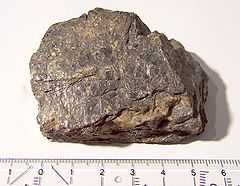Fergusonite
| Fergusonite | |
|---|---|
 | |
| General | |
| Category | Oxide minerals |
| Formula (repeating unit) | RENbO4 (RE=Rare earth) |
| Strunz classification | 7.GA.05 |
| Identification | |
| Formula mass | 245.81 (Y) |
| Color | Black, Black, Brown, Gray, Yellow |
| Crystal habit | Metamict - Mineral originally crystalline, now amorphous due to radiation damage |
| Crystal system | Tetragonal - Dipyramidal (4/m) I 41/a |
| Cleavage | Indistinct |
| Fracture | Sub Conchoidal - Fractures developed in brittle materials characterized by semi-curving surfaces |
| Mohs scale hardness | 5.5-6 |
| Luster | Sub Metallic |
| Streak | Brown |
| Density | 4.3 - 5.8, Average = 5.05 |
| Refractive index | 2.05-2.19, isotropic |
| Other characteristics | Nonmagnetic, Non-fluorescent, Not Radioactive |
| References | [1] |
Fergusonite is a mineral comprising a complex oxide of various rare earth elements. The chemical formula of fergusonite species is (Y,RE)NbO4, where RE = rare-earth elements in solid solution with Y. Yttrium is usually dominant (the species fergusonite-(Y)), but sometimes Ce or Nd may predominate in molar proportion (species fergusonite-(Ce) and fergusonite-(Nd)). All the other rare earth elements are present in subordinate amount, and tantalum substitutes for some of the niobium. There are Fergusonite-beta-(Nd), Fergusonite-beta-(Y), Fergusonite-beta-(Ce) too, but they are classified as 4.DG.10 in the Nickel-Strunz system. The mineral has tetragonal crystal symmetry and the same structure as scheelite (calcium tungstate, CaWO4), but can be metamict (amorphous) due to radiation damage from its small content of thorium. It is found as needle-like or prismatic crystals in pegmatite. It was named after British Politician and mineral collector Robert Ferguson of Raith (1767–1840).[2]
See also
References
| Wikimedia Commons has media related to Fergusonite. |